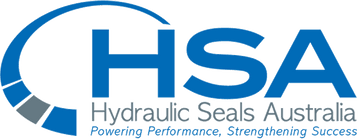Hydraulic seals make up the smallest fraction of cost during a cylinder repair, yet too often we hear feedback after a failure that the “seals are leaking” or “the seals have failed”. Truth be told, failure related directly to the seal also makes up the smallest fraction of reasons why the hydraulic cylinder has actually failed.
Most failures are caused by factors such as poor surface finishes, excessive extrusion gaps, incorrect housing sizes, poor oil quality, excessive heat and pressures and incorrect assembly, be it related to the installation of the seals in the cylinder or to the installation of the cylinder to the working equipment. All these factors play a massive roll in the performance and longevity of a hydraulic seal and can be a common cause of premature failure.
While modern day polyurethanes and seal profiles are designed to be used in arduous demanding applications, successful performance and longevity is still directly related to factors as mentioned above. Poor surface finishes will create excessive wear, excessive extrusion gaps will restrict the seals capability of withstanding pressure, incorrect housing sizes can cause both mentioned issues. Poor oil quality, particularly if contaminated by metallic particles will embed in the seal causing severe damage. Incorrect installation of the seals will result in seals rolling or being pinched and incorrect installation of the cylinder to the working equipment can cause issues if not aligned correctly or if the cylinder and attachments are not bled and cleared of any air.
In the paragraphs below, we will highlight failure caused due to excessive extrusion gaps and recommendations to avoid these problems. Firstly, we need to understand what the extrusion gap is.
The extrusion gap is the amount of clearance between the housing directly behind, or on either side of the seal groove, to either the rod or bore respectively. The larger the extrusion gap, the less pressure the seal can manage due to the increased gap for the seal material to extrude into.

The clear sign of a seal failure, or impending failure due to extrusion is “feathering” on the heel of the seal. This is the part of the seal that sits up against the extrusion gap. Feathering, depending on the size of the extrusion gap can present in different ways. We can see from the images below that the larger extrusion gaps present in a much more catastrophic way than that of a smaller, but still excessive extrusion gap.

So how do we prevent this from happening?
The easiest and most common fix is to replace the current seal with one that incorporates an extrusion ring or a full radial back up that minimises the extrusion gap. These are usually made from Glass Filled Acetal compounds, there are also options for different materials that are suitable for certain applications that help with extrusion issues that we will cover in our Bi-Monthly blog. Even so, there are limitations with these easy, common fix options.
To be confident in eliminating extrusion we need to know two key pieces of information being:
A) what is the extrusion gap measure? and
B) what pressure does the cylinder operate at?
By using these pieces of information in conjunction with our HSA profile data sheets you can make an informed decision on and subsequently provide a sealing option that is effective at eliminating extrusion.
We can see from the insert below, how as the extrusion gap increases the pressure decreases. We can also see how a seal with an Anti-extrusion ring (XPRA) can handle higher pressures at larger extrusion gaps than that without (XP). This is due to the presence of the Anti-Extrusion Ring that is made from a far harder material than the seal, essentially blocking the softer primary seal from extruding into the extrusion gap.


Having access to extrusion capabilities of seals and correct housing tolerances is essential to eliminating premature cylinder failure. With correct data we can help you make informed product decisions, saving labor, downtime and costly repairs.
For any uncertainties regarding cylinder repairs or when designing a new cylinder for any manner of applications please contact your local H.S.A branch to discuss the optimal seal choice for your project.




